您好,登錄后才能下訂單哦!
您好,登錄后才能下訂單哦!
這篇文章主要為大家展示了“Java8中Stream API如何終止”,內容簡而易懂,條理清晰,希望能夠幫助大家解決疑惑,下面讓小編帶領大家一起研究并學習一下“Java8中Stream API如何終止”這篇文章吧。
我們都知道Stream API完成的操作是需要三步的:創建Stream → 中間操作 → 終止操作。那么這篇文章就來說一下終止操作。
終端操作會從流的流水線生成結果。其結果可以是任何不是流的值,例如:List、Integer,甚至是 void 。
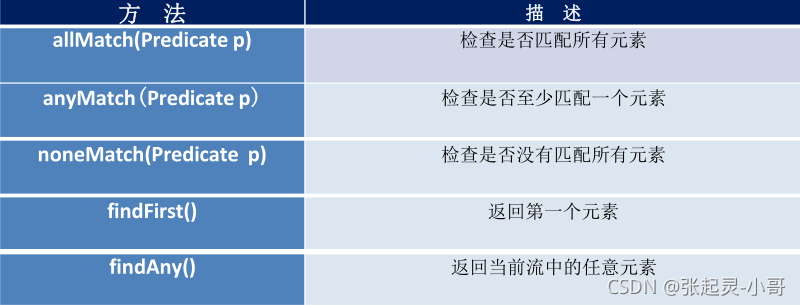
首先,我們仍然需要一個自定義的Employee類,以及一個存儲它的List集合。
在Employee類定義了枚舉(BUSY:忙碌;FREE:空閑;VOCATION:休假)
package com.szh.java8;
import lombok.AllArgsConstructor;
import lombok.Data;
import lombok.NoArgsConstructor;
/**
*
*/
@Data
@NoArgsConstructor
@AllArgsConstructor
public class Employee2 {
private Integer id;
private String name;
private Integer age;
private Double salary;
private Status status;
public Employee2(Integer id) {
this.id = id;
}
public Employee2(Integer id, String name) {
this.id = id;
this.name = name;
}
public enum Status {
FREE,
BUSY,
VOCATION
}
}List<Employee2> employees = Arrays.asList( new Employee2(1001,"張三",26,6666.66, Employee2.Status.BUSY), new Employee2(1002,"李四",50,1111.11,Employee2.Status.FREE), new Employee2(1003,"王五",18,9999.99,Employee2.Status.VOCATION), new Employee2(1004,"趙六",35,8888.88,Employee2.Status.BUSY), new Employee2(1005,"田七一",44,3333.33,Employee2.Status.FREE), new Employee2(1005,"田七二",44,3333.33,Employee2.Status.VOCATION), new Employee2(1005,"田七七",44,3333.33,Employee2.Status.BUSY) );
查找所有的員工是否都處于BUSY狀態、至少有一個員工處于FREE狀態、沒有員工處于VOCATION狀態。
@Test
public void test1() {
boolean b1 = employees.stream()
.allMatch((e) -> e.getStatus().equals(Employee2.Status.BUSY));
System.out.println(b1);
boolean b2 = employees.stream()
.anyMatch((e) -> e.getStatus().equals(Employee2.Status.FREE));
System.out.println(b2);
boolean b3 = employees.stream()
.noneMatch((e) -> e.getStatus().equals(Employee2.Status.VOCATION));
System.out.println(b3);
}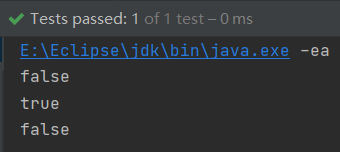
對員工薪資進行排序之后,返回第一個員工的信息; 篩選出BUSY狀態員工之后,返回任意一個處于BUSY狀態的員工信息。
@Test
public void test2() {
Optional<Employee2> op1 = employees.stream()
.sorted((e1, e2) -> Double.compare(e1.getSalary(), e2.getSalary()))
.findFirst();
System.out.println(op1.get());
System.out.println("----------------------------------");
Optional<Employee2> op2 = employees.stream()
.filter((e) -> e.getStatus().equals(Employee2.Status.BUSY))
.findAny();
System.out.println(op2.get());
}
下面,我們來看一下另外一組查找與匹配的方法。

計算處于VOCATION狀態的員工數量;對員工薪資字段進行映射,同時獲取其中的最高薪資;獲取年齡最小的員工信息。
@Test
public void test3() {
long count = employees.stream()
.filter((e) -> e.getStatus().equals(Employee2.Status.VOCATION))
.count();
System.out.println(count);
Optional<Double> op1 = employees.stream()
.map(Employee2::getSalary)
.max(Double::compare);
System.out.println(op1.get());
Optional<Employee2> op2 = employees.stream()
.min((e1, e2) -> Integer.compare(e1.getAge(), e2.getAge()));
System.out.println(op2.get());
}
在這里,大家需要注意的一點就是:當前Stream流一旦進行了終止操作,就不能再次使用了。
我們看下面的代碼案例。(異常信息說的是:stream流已經被關閉了)
@Test
public void test4() {
Stream<Employee2> stream = employees.stream()
.filter((e) -> e.getStatus().equals(Employee2.Status.BUSY));
long count = stream.count();
stream.map(Employee2::getName);
}


Collector 接口中方法的實現決定了如何對流執行收集操作 (如收集到 List、Set、Map) 。但是 Collectors 實用類提供了很多靜態方法,可以方便地創建常見收集器實例,具體方法與實例如下表:
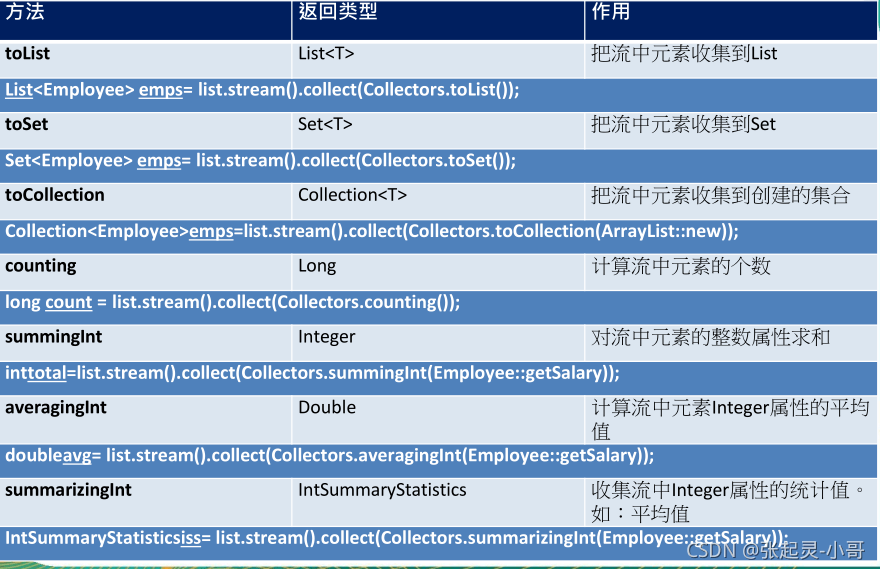
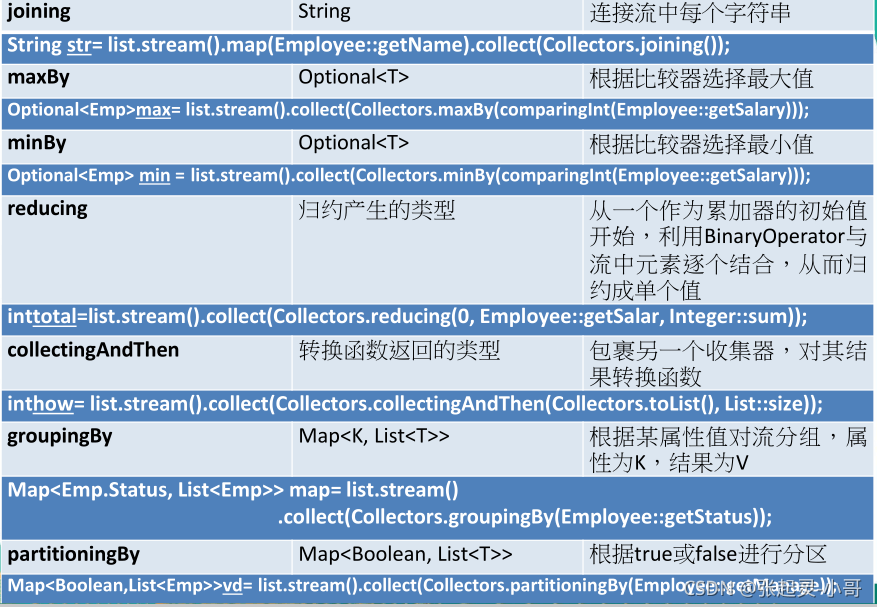
計算整數1~10的和;對員工薪資字段進行映射,之后獲取所有員工的薪資總和。
@Test
public void test1() {
List<Integer> list = Arrays.asList(1,2,3,4,5,6,7,8,9,10);
Integer sum = list.stream()
.reduce(0, (x, y) -> x + y);
System.out.println(sum);
System.out.println("-------------------------------");
Optional<Double> optional = employees.stream()
.map(Employee2::getSalary)
.reduce(Double::sum);
System.out.println(optional.get());
}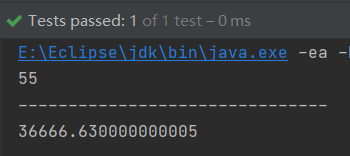
依次對我們先前定義好的存儲員工信息的List集合 做name字段的映射,然后 轉為 List、Set、HashSet(使用 Collectors 實用類中的靜態方法即可完成)。
在Set、HashSet集合中,由于元素是無序、不可重復的,所以只有一個田七二。
@Test
public void test2() {
List<String> list = employees.stream()
.map(Employee2::getName)
.collect(Collectors.toList());
list.forEach(System.out::println);
System.out.println("-------------------------------");
Set<String> set = employees.stream()
.map(Employee2::getName)
.collect(Collectors.toSet());
set.forEach(System.out::println);
System.out.println("-------------------------------");
HashSet<String> hashSet = employees.stream()
.map(Employee2::getName)
.collect(Collectors.toCollection(HashSet::new));
hashSet.forEach(System.out::println);
}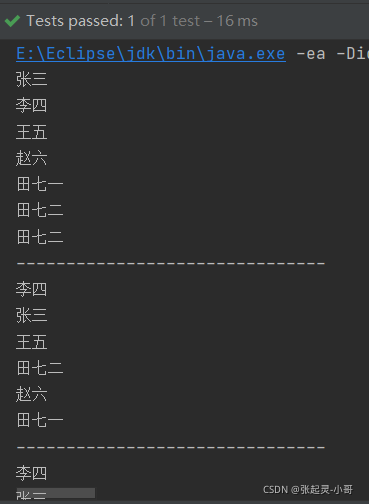
對員工薪資字段做映射,之后通過比較器獲取最高薪資;
不做映射處理,直接通過比較器獲取薪資最低的員工信息;
計算所有員工的薪資總和;
計算所有員工的平均薪資;
計算員工總數;
對員工薪資字段做映射,之后通過比較器獲取最高薪資;
@Test
public void test3() {
Optional<Double> max = employees.stream()
.map(Employee2::getSalary)
.collect(Collectors.maxBy(Double::compare));
System.out.println(max.get());
Optional<Employee2> min = employees.stream()
.collect(Collectors.minBy((e1, e2) -> Double.compare(e1.getSalary(), e2.getSalary())));
System.out.println(min.get());
Double sum = employees.stream()
.collect(Collectors.summingDouble(Employee2::getSalary));
System.out.println(sum);
Double avg = employees.stream()
.collect(Collectors.averagingDouble(Employee2::getSalary));
System.out.println(avg);
Long count = employees.stream()
.collect(Collectors.counting());
System.out.println(count);
DoubleSummaryStatistics dss = employees.stream()
.collect(Collectors.summarizingDouble(Employee2::getSalary));
System.out.println(dss.getMax());
}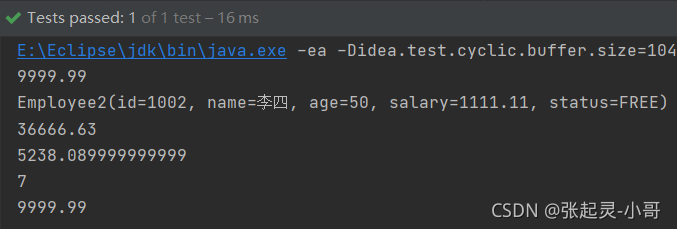
單個條件分組:根據員工狀態對Stream流進行分組。 因為分組之后得到的是一個Map集合,key就是員工狀態,value則是一個List集合。
@Test
public void test4() {
Map<Employee2.Status, List<Employee2>> map = employees.stream()
.collect(Collectors.groupingBy(Employee2::getStatus));
Set<Map.Entry<Employee2.Status, List<Employee2>>> set = map.entrySet();
Iterator<Map.Entry<Employee2.Status, List<Employee2>>> iterator = set.iterator();
while (iterator.hasNext()) {
Map.Entry<Employee2.Status, List<Employee2>> entry = iterator.next();
System.out.println(entry.getKey());
System.out.println(entry.getValue());
}
}
多個條件分組:先按照員工狀態分組,如果狀態相同,再按照員工年齡分組。
@Test
public void test5() {
Map<Employee2.Status, Map<String, List<Employee2>>> map = employees.stream()
.collect(Collectors.groupingBy(Employee2::getStatus, Collectors.groupingBy((e) -> {
if (e.getAge() <= 35) {
return "成年";
} else if (e.getAge() <= 60) {
return "中年";
} else {
return "老年";
}
})));
Set<Employee2.Status> set = map.keySet();
Iterator<Employee2.Status> iterator = set.iterator();
while (iterator.hasNext()) {
Employee2.Status next = iterator.next();
Map<String, List<Employee2>> listMap = map.get(next);
System.out.println(next);
System.out.println(listMap);
}
}
根據特定的條件對員工進行分區處理。(員工薪資大于等于5000為 true 分區;否則都為 false 分區)。
@Test
public void test6() {
Map<Boolean, List<Employee2>> map = employees.stream()
.collect(Collectors.partitioningBy((e) -> e.getSalary() >= 5000));
map.forEach((key,value) -> System.out.println("鍵:" + key + ", 值:" + value));
}
以上是“Java8中Stream API如何終止”這篇文章的所有內容,感謝各位的閱讀!相信大家都有了一定的了解,希望分享的內容對大家有所幫助,如果還想學習更多知識,歡迎關注億速云行業資訊頻道!
免責聲明:本站發布的內容(圖片、視頻和文字)以原創、轉載和分享為主,文章觀點不代表本網站立場,如果涉及侵權請聯系站長郵箱:is@yisu.com進行舉報,并提供相關證據,一經查實,將立刻刪除涉嫌侵權內容。